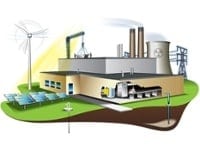Green Industrial Building Trends
There’s no question that green building construction and efficient commercial ventilation design have hit its stride in mainstream adoption. When government agencies are adopting such standards and telling their departments to use them whenever possible, some may say that the trend has truly become established. As a result, it’s important for construction companies and interior system installers to understand these green industrial building trends.
Industrial Building Trends
There will be an emphasis on systems that allow large-scale commercial and industrial facilities to use less energy while improving efficiency. We’ve seen the advancements achieved by the installation of better insulation, more efficient lighting, and improvements in water heating technology. However, when it comes to the field of ventilation, there is still a lot of progress to make. Improved ventilation, along with the adoption of other energy efficiency strategies, is poised to become the next big green building trend.

The integration of building system management and computers is likely to grow significantly. With the level of Internet and Cloud tools available , one can handle all a building’s remotely. Users can adjust ventilation, lighting, irrigation, and security from one central control area. Plus, by tying-in data usage information and data collection tools, managers can get the most accurate information available. This will allow them to better plan production schedules and figure out how to get the most out of their system, as well as be able to see if there are any issues or broken components such as valves, valve controllers, pipe leakages and more.
Installers and construction companies will soon offer these advanced computer systems everywhere. Instead of trying to figure out when the fans are used the most or when they are likely to burn out, the building manager can just share the data with the manufacturer remotely. This advanced degree of service simply wouldn’t have been possible a few years ago. Having any type of building or construction work taking place on your building can be frustrating, especially thinking about how much mess will be made.
Reporting
It’s not enough to have a green building. Many companies will also feel pressure from various sources to report and tell everyone about it. Benefits can range from community goodwill and positive PR to making the CEO look good with lower utility costs. In many cases, the advancements in technology allow for more accurate, consistent, and persistent data reporting.
Of course, over time new standards also mean that there will be a new normal. As the government adopts requirements like LEED standards, the private sector is likely to follow.
Healthy Building Design Industrial Building Trends
HVAC systems designed to be the definitive answer in building cooling, sometimes lead to people mold and people getting sick. Bigger and bigger buildings mean people see sunlight less and less. Fortunately, the new movement to not just technically advanced but also healthy building design places greater emphasis on avoiding such problems and keeping workers inside healthy.
Solar Power Usage
The increasing affordability of solar power means the space on top of a building will be put to effective use. The dropping cost of solar panels makes these systems a worthwhile investment for businesses. Industrial building trends in 2014 will see more questions by companies considering the idea.
Natural Ventilation
In addition to adding to a building’s roof, taking away from a building’s roof can help a lot too. By opening a building’s rooftop and installing natural ventilators air flow inside of the facility will increase. This will help a building to keep cool by letting warm up rise and out of a building. A variety of buildings use this technique. Buildings as diverse as steel mills and power plants to college campuses and office buildings all use natural ventilation.
Water Conservation
With the weather system change worldwide, droughts and water limitations are becoming more commonplace. One of the biggest consumers of water tends to be large, commercial facilities. Therefore, water conservation efforts will become more commonplace. Reducing water consumption lowers the energy consumed to move the water. Furthermore, this minimizes the associated water costs as well.
Finding green building standards experts who can provide necessary changes without breaking the bank will find market opportunities in 2014. It’s important to understand, however, that the above demands are not temporary trends. Given the increasing awareness of limited resources, rising utility costs, and the need to control the effects of consumption, green industrial building trends are here to stay. In fact, they are likely to evolve as new energy efficient technologies become available. Do you want to learn more about the effect of building construction on environment? Don’t forget to visit our blog page.
